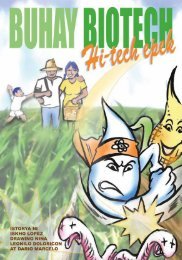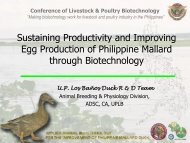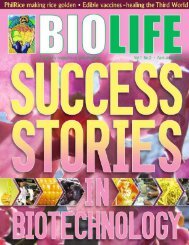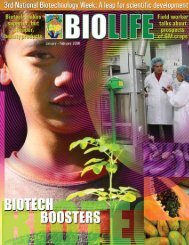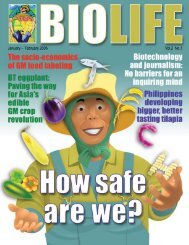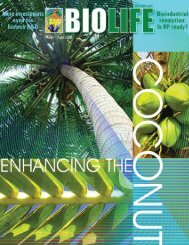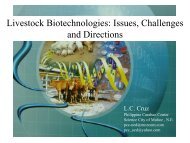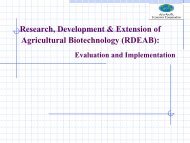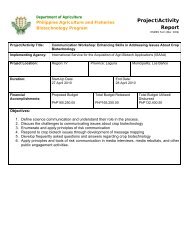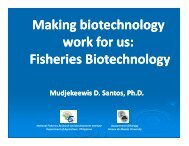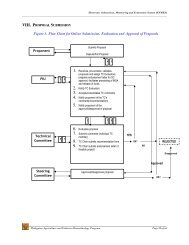Download PDF - SEARCA Biotechnology Information Center
Download PDF - SEARCA Biotechnology Information Center
Download PDF - SEARCA Biotechnology Information Center
You also want an ePaper? Increase the reach of your titles
YUMPU automatically turns print PDFs into web optimized ePapers that Google loves.
January – March 2005 BIO LIFE<br />
31<br />
with biotech crops—for the past nearly 20 years—and the<br />
findings all show the benefits outweighing any potential (because<br />
none has been discovered) risk. The biotech crops that<br />
are more pest-resistant have in fact greatly reduced the risk of<br />
chemical poisoning that has occurred in some places where<br />
pesticides were not used prudently.<br />
In Western Europe, where the biotech protest movement is<br />
very strong, the European Commission concluded, after an<br />
analysis of scientific evidence from 81 research projects, that:<br />
“The use of more precise technology and the greater regulatory<br />
scrutiny probably make [biotech crops] even safer than conventional<br />
plants and foods.”<br />
WHAT IS A ‘GM’ CROP<br />
The biggest debate in biotechnology has centered the past<br />
few years on such terms as “GMO” and “GM crops,” or genetically<br />
modified organisms or crops.<br />
In reality, all crops are really “genetically modified” from their<br />
original wild state by various processes of domestication,<br />
selection and controlled breeding over long periods of time.<br />
A GM or transgenic crop is one where such natural modification<br />
is hastened by a deliberate scientific process. A GM crop<br />
contains a gene(s) that has been artificially inserted, instead of<br />
the plant acquiring it through pollination. The inserted gene<br />
(known as the transgene) may come from another unrelated<br />
plant, or from a completely different species.<br />
WHY ARE ‘GM’ CROPS MADE<br />
Plant breeders have been exchanging genes between plants<br />
to produce offspring with desired traits; but this crossbreeding<br />
has been limited to exchanges between closely related or the<br />
same species—which takes a long time to produce the desired<br />
results or changes in features.<br />
With GM technology, scientists can bring together in one<br />
plant the useful genes of a diverse range of living sources, not<br />
just within the crop species or closely related plants. This<br />
speeds up the work of producing superior plant varieties.<br />
The use of the so-called “first-generation” GM crops has<br />
yielded significant benefits thus far, primarily, as stated above, in<br />
terms of bigger produce, lower farm costs and higher farm profit,<br />
and an improvement in the environment. Now, the “secondgeneration”<br />
GM crops have the additional advantage of being<br />
infused with nutritive qualities that address the dietary deficiencies<br />
of people. Examples of such crops are potatoes with higher<br />
starch content; rice enriched with iron and vitamin A; and edible<br />
vaccines in maize and potatoes.<br />
AREN’T THERE RISKS IN USING ‘GM’ CROPS<br />
All emerging technologies and scientific developments carry<br />
risks, among them: (1) the possibility transgenes will escape<br />
from cultivated crops into wild relatives; or (2) the peril of<br />
unintentional introduction of allergens into food; or of (3) pests<br />
becoming resistant, through time, to the toxins produced by<br />
GM crops.<br />
However, legislation and regulatory institutions dictate<br />
processes that entail careful review of applications to precisely<br />
avoid or reduce these risks. The technology innovators (i.e.,<br />
scientists), the producers and the government has the obligation<br />
to ensure the safety of novel food and drugs for people and their<br />
benign impact on the environment.




